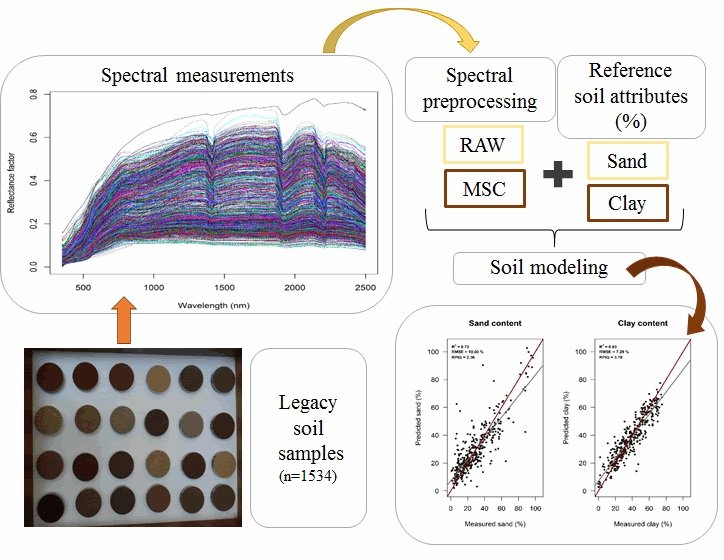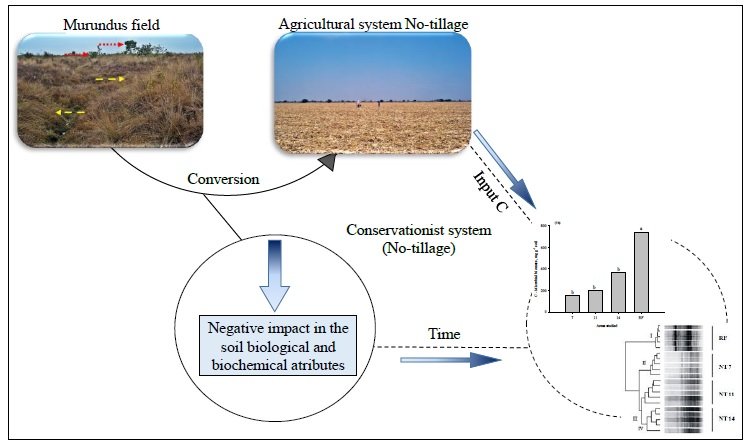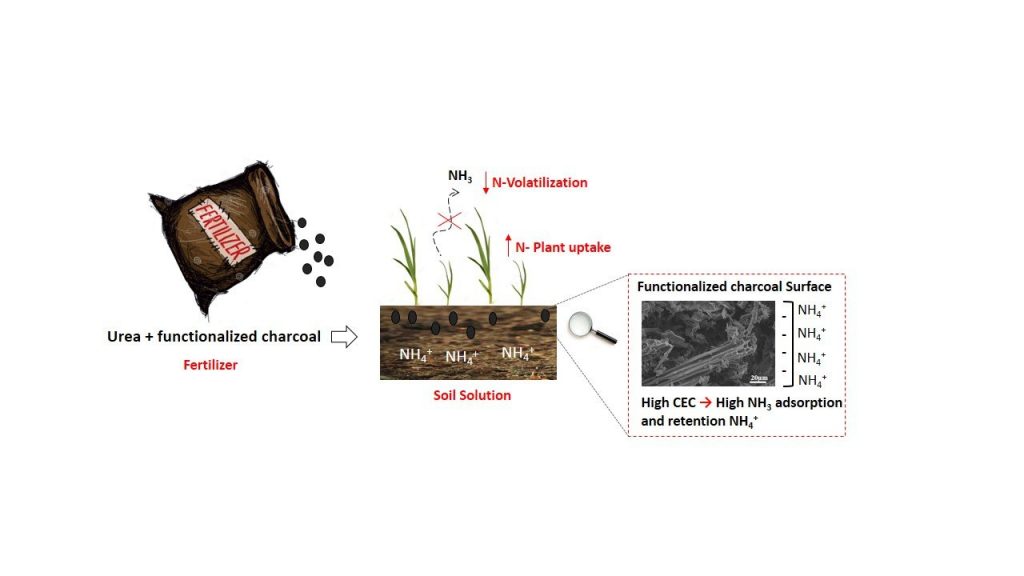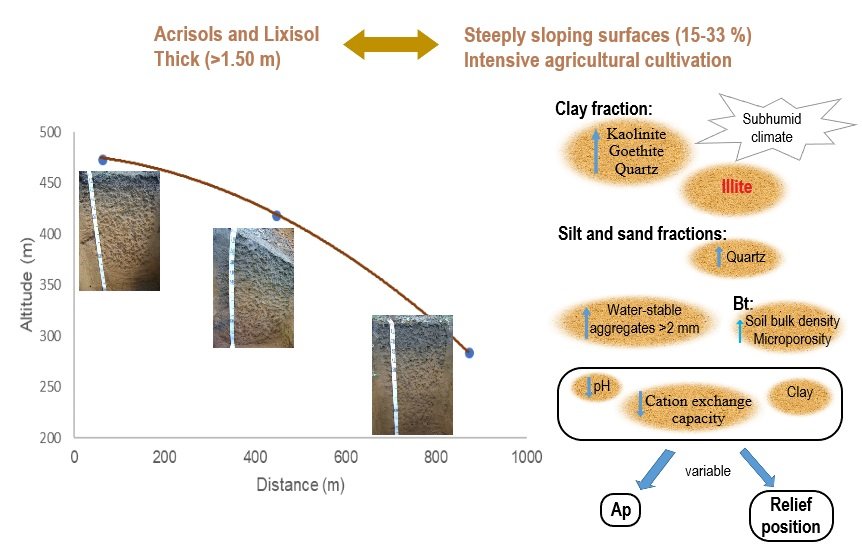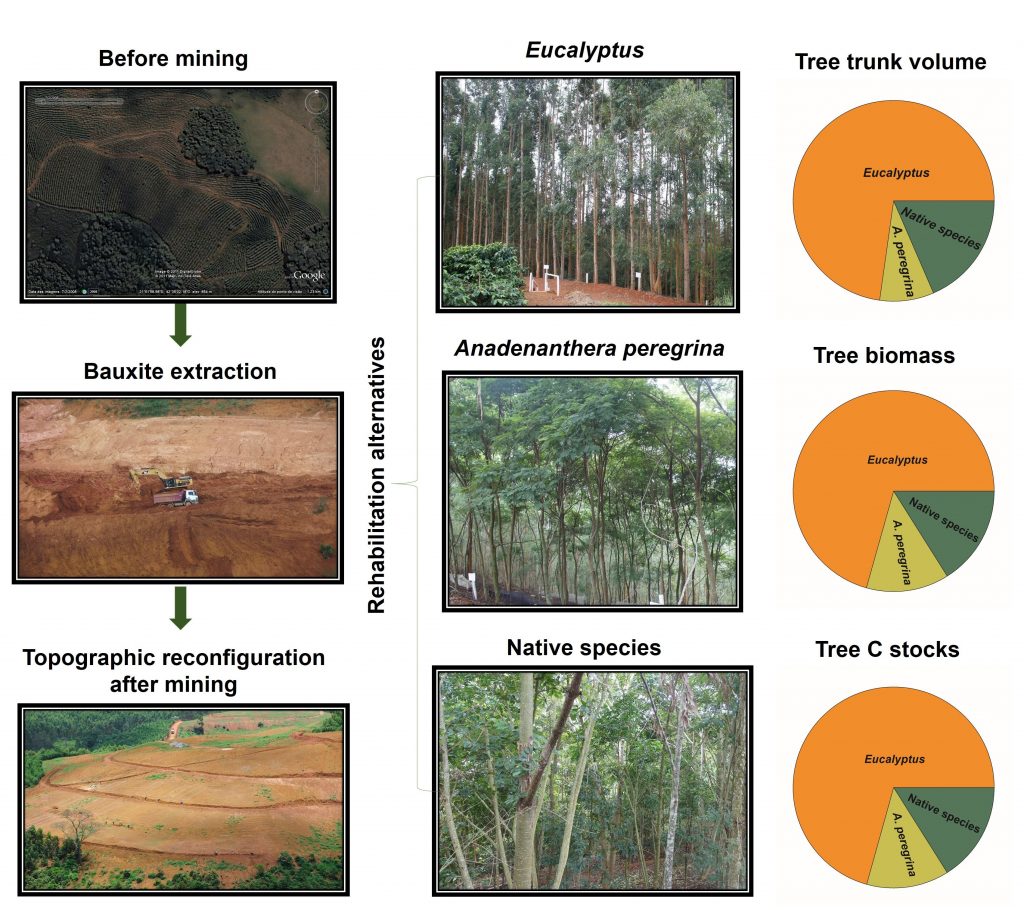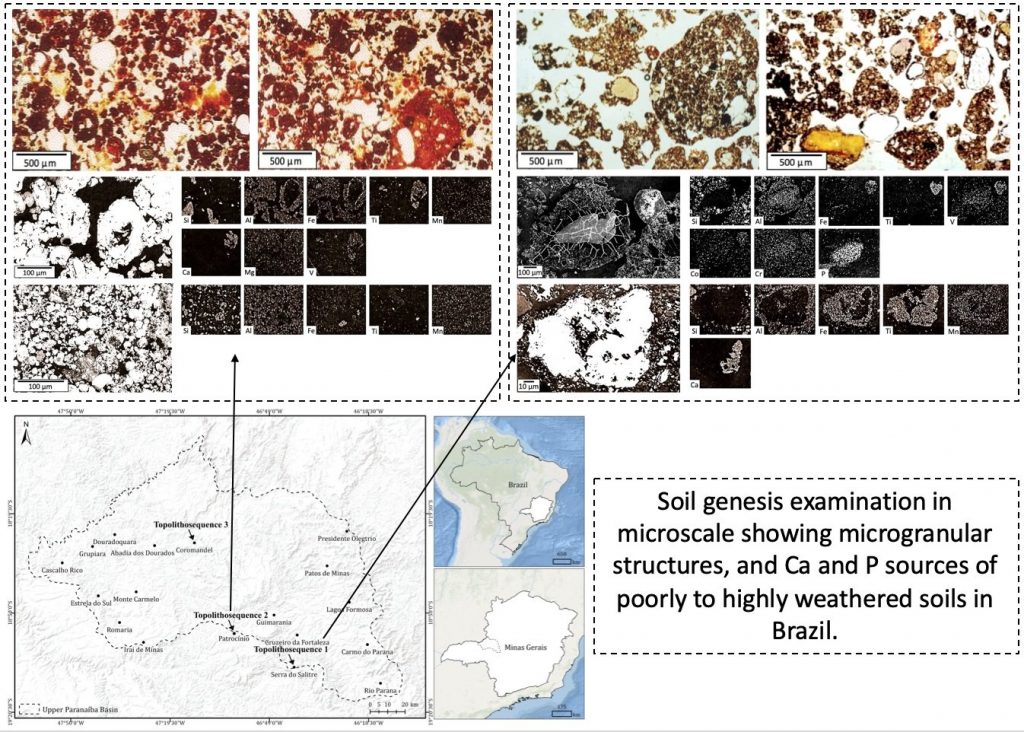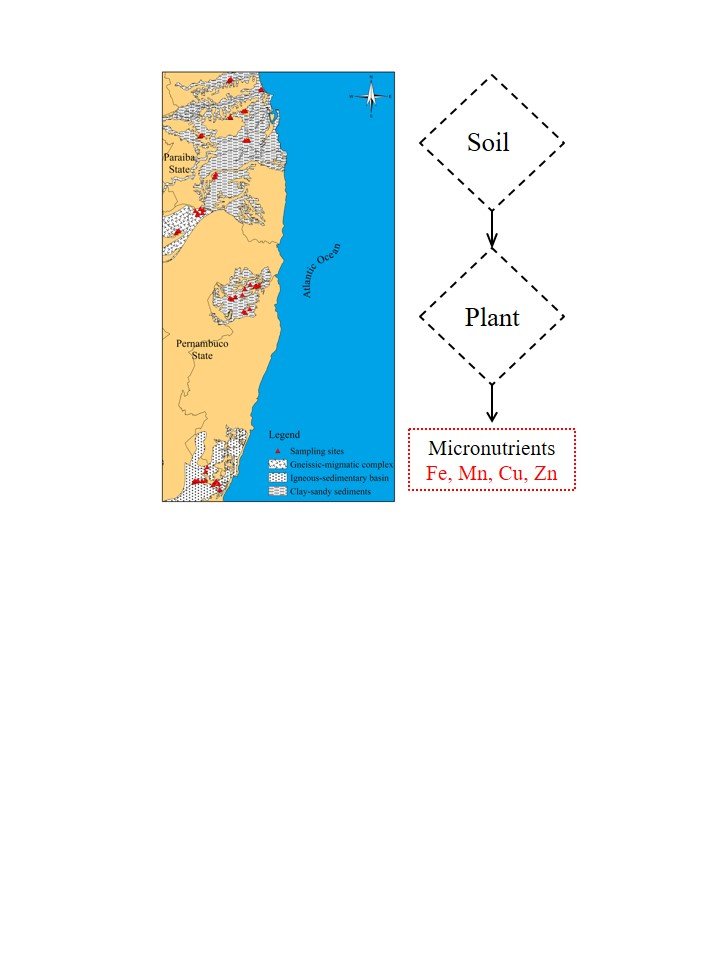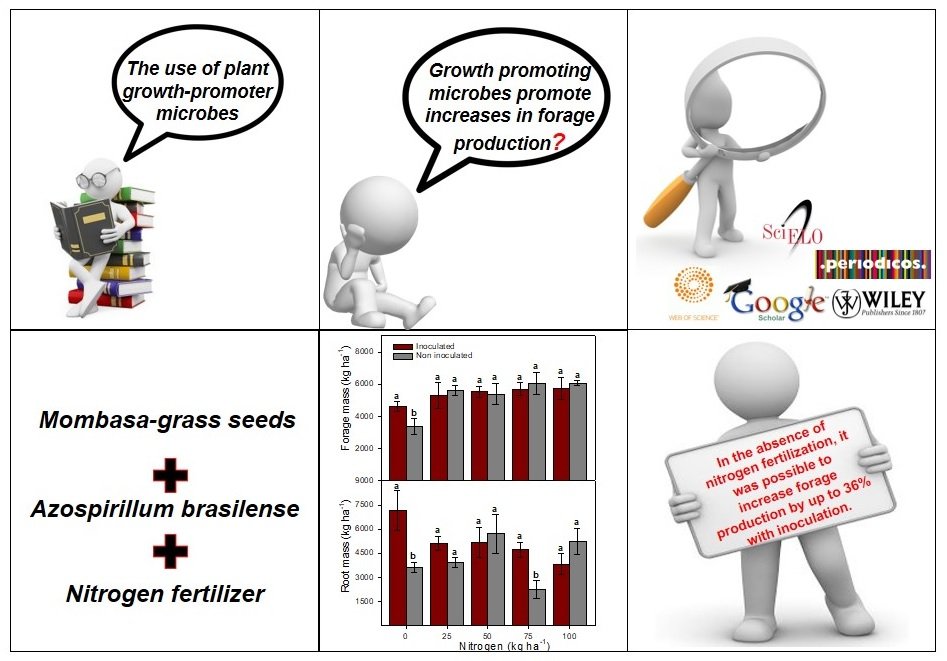Volume 43, 2019
A Regional Legacy Soil Dataset for Prediction of Sand and Clay Content with Vis-Nir-Swir, in Southern Brazil
12/ago/2019
ABSTRACT The success of soil prediction by VIS-NIR-SWIR spectroscopy has led to considerable investment in large soil spectral libraries. The aims of this study were 1) to develop a soil VIS-NIR-SWIR spectroscopy approach using legacy soil samples to improve spectral soil information in a regional scale; (2) to compare six spectral preprocessing techniques; and (3) to compare the performance of linear and non-linear multivariate models for prediction of sand and clay content. A total of 1,534 legacy soil samples, stored […]
Biochemical and Biological Properties of Soil from Murundus Wetlands Converted into Agricultural Systems
14/jun/2019
ABSTRACT The implementation of conservationist systems that improve soil properties and reduce the impacts of the conversion of native areas is fundamental for feasible agricultural exploitation. This study aimed to evaluate the impact on soil biological properties caused by the conversion of murundus fields into agricultural systems and verify the ability of the no-tillage conservation system to recover these properties over the years. Treatments consisted of three agricultural areas subjected to the same management (no-tillage), in a chronosequence (7, 11, […]
Value of Functionalized Charcoal for Increasing the Efficiency of Urea N Uptake: Insights into the Functionalization Process and the Physicochemical Characteristics of Charcoal
12/ago/2019
ABSTRACT Functionalized charcoal (CHox) incorporated into urea is known for its ability to reduce NH3 volatilization and increase agronomic efficiency. However, it is important to optimize the functionalization process and to elucidate its relationship with the physicochemical properties of CHox for N supply. Thus, charcoal obtained from eucalyptus wood was functionalized with different HNO3 concentrations and reaction times. Ammonia adsorption by CHox was evaluated in chambers with high NH3 concentrations. Dry matter yield, N uptake, and apparent N recovery efficiency […]
Relief Position and Soil Properties under Continuous Banana Cropping in Subhumid Climate in Northeast Brazil
20/ago/2019
ABSTRACT Sequences of thick and eroded soils in hills surfaces are cultivated with banana since the beginning of the last century in the Northeast of Pernambuco (PE), Brazil. Measurements of soil properties depending on soil slope under intensive agricultural cultivation are limited mostly as the pedogenetic approach. This study aimed to identify the dominant soil types, to evaluate morphological, physical, chemical, and mineralogical properties of soil profiles, and link them to the relief position under continuous banana cropping, in the […]
Growth, Biomass and Carbon Stocks in Forest Cover Planted in an Area of Bauxite Mining in Rehabilitation
26/nov/2019
ABSTRACT Forest cover in areas degraded by mining is an alternative way of mitigating CO2 concentrations in the atmosphere by fixing C in tree biomass. This study evaluated the growth and C stocks of forest cover in an area of bauxite mining with four sources of fertilizer. Height (Ht), diameter at ground level (DGL), and diameter at breast height (DBH) were determined in Anadenanthera peregrina (Ap), clonal Eucalyptus (Euc), and a mixed plantation of 16 native forest species (Nat) at […]
Performance of the Groenevelt and Grant Model for Fitting Soil Water Retention Data from Brazilian Soils
17/jul/2019
ABSTRACT The soil water retention curve (SWRC) is essential for vadose zone hydrological modeling and related applications. In 2004, Groenevelt and Grant (GRT) presented a mathematical model for describing the SWRC and reported its mathematical versatility and good fit to soils from a Dutch database. In order to evaluate the application of GRT to SWRCs of Brazilian soils, we aimed to analyze the performance of GRT for 72 soils from Brazil. Besides that, the obtained results with GRT for these […]
Micromorphology and Genesis of Soils from Topolitosequences in the Brazilian Central Plateau
04/set/2019
ABSTRACT The micromorphology of deeply weathered soils (Ferralsols/ Latossolos ) from the Central Plateau of Brazil remains little studied, and its affiliation to different parent materials, poorly known. To clarify the processes of soil formation of these acric, gibbsitic, Fe-oxide rich Ferralsols, three lithotoposequences on local ultrabasic to basic intrusive rocks were studied. The influences of mixing and pedobioturbation are evident in all soils, and Ferralsols of the Central Plateau of Brazil are polygenetic, based on the coarse mineral composition, […]
Phosphate Sources and Filter Cake Amendment Affecting Sugarcane Yield and Soil Phosphorus Fractions
22/maio/2019
ABSTRACT: The use of mineral phosphate fertilizers associated with organic residues can improve fertilizer use efficiency and consequently decrease their usage costs. Soil application of filter cake (FC) can provide nutrients and enhance physical quality. This study aimed to evaluate the effects of different phosphate fertilizers [rock phosphate (RP) and triple superphosphate (TSP)] applied at different rates (90 and 180 kg ha-1 P2O5) associated with filter cake (10 Mg ha-1 dry matter) on the soil phosphorus (P) fractions after two […]
Assessing the Content of Micronutrients in Soils and Sugarcane in Different Pedogeological Contexts of Northeastern Brazil
25/jul/2019
ABSTRACT Micronutrient research for sugarcane in northeastern Brazil is scarce and most works on this issue date back to the 70’s and 80’s. The objectives of this study were to assess the available and reserve pools of Fe, Mn, Cu, and Zn in soils cultivated with sugarcane under three geological contexts in northeastern Brazil as well as to diagnose the micronutrient nutritional status of sugarcane grown on these areas in order to identify pedogeological conditions in which micronutrient deficiencies are […]
Mitigation of Mombasa Grass ( Megathyrsus maximus ) Dependence on Nitrogen Fertilization as a Function of Inoculation with Azospirillum brasilense
20/ago/2019
ABSTRACT Using biological inputs to improve the efficiency of nitrogen fertilizers represents an alternative for the cultivation of grasses in tropical regions. Azospirillum brasilense is a species of plant growth promoting bacteria widely studied and used in inoculants. Thus, this study aimed to evaluate the performance of Mombasa grass ( Megathyrsus maximus ) in association with A. brasilense and nitrogen (N) fertilization. The study was conducted under field conditions in Araguaína-Tocantins State, between December 2017 and May 2018. The treatments […]

